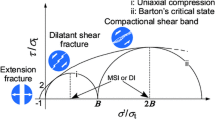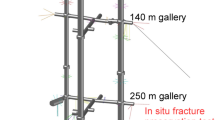Abstract
The long-term geological disposal of high-level radioactive waste relies on predictions of future changes in a disposal facility’s hydro-mechanical characteristics to assess potential leakage through fractures in the excavation damaged zone (EDZ) after backfilling the facility. This study evaluated the transmissivity of EDZ fractures using in situ hydraulic tests around the area of a full-scale, experimental, engineered barrier system in the Horonobe Underground Research Laboratory, Hokkaido, Japan. After their installation, the buffer blocks swelled, altering the stresses within the EDZ fractures. The effects of these changing stresses on the fractures’ transmissivity were assessed over a period of 4 years. The transmissivity continuously decreased in this period to about 41% of its value measured prior to the swelling. Using the Barton–Bandis normal-stress-dependent fracture-closure model, the decrease in transmissivity is quantitatively attributed to closure of the EDZ fractures, which was caused by the swelling pressure increasing up to 0.88 MPa. Evidence of fracture closure came from seismic tomography surveying, which revealed a slight increase in seismic velocity in the study area with increasing swelling pressure. The results show that EDZ fractures were closed by swelling of the full-scale buffer material. They also demonstrate the applicability of the Barton–Bandis model to preliminary estimation of the long-term transmissivity of EDZ fractures in facilities for the geological disposal of radioactive waste.





















Similar content being viewed by others
Data availability
The data that support the findings of this study are available from the corresponding author upon reasonable request.
References
Aoyagi K, Ishii E (2019) A method for estimating the highest potential hydraulic conductivity in the excavation damaged zone in mudstone. Rock Mech Rock Eng 52:385–401. https://doi.org/10.1007/s00603-018-1577-z
Aoyagi K, Tsusaka K, Kubota K, Tokiwa T, Kondo K, Inagaki D (2014) Investigations for a change of an excavation damaged zone with time at the 250 m gallery in the Horonobe Underground Research Laboratory. Jpn J JSCE C (geotechnics) 70:412–423. https://doi.org/10.2208/jscejge.70.412
Aoyagi K, Miyara N, Ishii E, Nakayama M, Kimura S (2018) Evolution of the excavation damaged zone around a modelled disposal pit: case study at the Horonobe Underground Research Laboratory Japan. Proc SEGJ Int Symp. https://doi.org/10.1190/SEGJ2018-114.1
Aoyagi K, Ishii E, Chen Y, Ishida T (2022) Resin-injection testing and measurement of the shear displacement and aperture of excavation-damaged-zone fractures: a case study of mudstone at the Horonobe Underground Research Laboratory, Japan. Rock Mech Rock Eng 55:1855–1869. https://doi.org/10.1007/s00603-022-02777-z
Armand G, Leveau F, Nussbaum C, Vaissiere RL, Noiret A, Jaeggi D, Landrein P, Righini C (2014) Geometry and properties of the excavation-induced fractures at the Meuse/Haute-Marne URL drifts. Rock Mech Rock Eng 47:21–41. https://doi.org/10.1007/s00603-012-0339-6
Baechler S, Lavanchy JM, Armand G, Cruchaudet M (2011) Characterisation of the hydraulic properties within the EDZ around drifts at level –490 m of the Meuse/Haute-Marne URL: a methodology for consistent interpretation of hydraulic tests. Phys Chem Earth 36:1922–1931. https://doi.org/10.1016/j.pce.2011.10.005
Barton N (1982) Modelling rock joint behaviour from in situ block tests: implications for nuclear waste repository design, ONWI-308. Office of Nuclear Waste Isolation, Columbus
Barton N, Bandis S, Bakhtar K (1985) Strength, deformation and conductivity coupling of rock joints. Int J Rock Mech Min Sci Geomech Abstracts 22:121–140. https://doi.org/10.1016/0148-9062(85)93227-9
Bock H, Dehandschutter B, Martin CD, Mazurek M, Haller A, Skoczylas F, Davy C (2010) Self-sealing of fractures in argillaceous formations in the context of geological disposal of radioactive waste. Review and synthesis. NEA Report 6184, OECD/NEA, Paris
Bossart P, Meier PM, Moeri A, Trick T, Mayor JC (2002) Geological and hydraulic characterization of the excavation disturbed zone in the Opalinus Clay of the Mont Terri Rock Laboratory. Eng Geol 66:19–38. https://doi.org/10.1016/S0013-7952(01)00140-5
Bossart P, Trick T, Meier PM, Mayor JC (2004) Structural and hydrogeological characterization of the excavation-disturbed zone in the Opalinus Clay (Mont Terri Project, Switzerland). Appl Clay Sci 26:429–448. https://doi.org/10.1016/j.clay.2003.12.018
Gueguen Y, Palciauskas V (1994) Introduction to the physics of rocks. Princeton University Press
International Society for Rock Mechanics (1978a) Suggested methods for determining tensile strength of rock materials. Int J Rock Mech Min Sci Geomech Abstr 15:99–103. https://doi.org/10.1016/0148-9062(78)90003-7
International Society for Rock Mechanics (1978b) Suggested methods for determining sound velocity. Int J Rock Mech Min Sci Geomech Abstr 15:53–58. https://doi.org/10.1016/0148-9062(78)91678-9
International Society for Rock Mechanics (1979a) Suggested methods for determining the uniaxial compressive strength and deformability of rock materials. Int J Rock Mech Min Sci Geomech Abstr 16:135–140. https://doi.org/10.1016/0148-9062(79)91451-7
International Society for Rock Mechanics (1979b) Suggested methods for determining water content, porosity, density, absorption and related properties and swelling and slake-durability index properties. Int J Rock Mech Min Sci Geomech Abstr 16:143–151. https://doi.org/10.1016/0148-9062(79)91452-9
Ishii E (2020) A conventional straddle-sliding-packer system as a borehole extensometer: monitoring shear displacement of a fault during an injection test. Eng Geol 275:105748. https://doi.org/10.1016/j.enggeo.2020.105748
Ishii E (2021) The highest potential transmissivities of fractures in fault zones: reference values based on laboratory and in situ hydro-mechanical experimental data. Eng Geol 294:106369. https://doi.org/10.1016/j.enggeo.2021.106369
Ishii E (2022) Constant-head step injection tests to quantify the stress dependence of fracture transmissivity in an excavation damaged zone: a case study from the Horonobe Underground Research Laboratory. Int J Rock Mech Min Sci 159:105229. https://doi.org/10.1016/j.ijrmms.2022.105229
Japan Nuclear Cycle Development Institute (2000) H12: project to establish the scientific and technical basis for HLW disposal in Japan—report 3 safety assessment of the geological disposal system. Tech Rep JNC TN1410 2000–004, Tokai-mura, Japan
Kang Y, Fan J, Jiang D, Li Z (2021) Influence of geological and environmental factors on the reconsolidation behavior of fine granular salt. Nat Resour Res 30:805–826. https://doi.org/10.1007/s11053-020-09732-1
Kikuchi H, Tanai K (2005) Basic characteristic test of buffer/backfill material under Horonobe groundwater condition (Testing Document). Tech Rep JNC TN8430 2004–005, Tokai-mura, Japan
Leucci G, Giorgi LD (2006) Experimental studies on the effect of fracture on the P and S wave velocity propagation in sedimentary rock (“Calcarenite del Salento”). Eng Geol 84:130–142. https://doi.org/10.1016/j.enggeo.2005.12.004
Levasseur S, Charlier R, Frieg B, Collin F (2010) Hydro-mechanical modelling of the excavation damaged zone around an underground excavation at Mont Terri Rock Laboratory. Int J Rock Mech Min Sci 47:414–425. https://doi.org/10.1016/j.ijrmms.2010.01.006
Li Y, Zhang Y (2015) Quantitative estimation of joint roughness coefficient using statistical parameters. Int J Rock Mech Min Sci 77:27–35. https://doi.org/10.1016/j.ijrmms.2015.03.016
Mavko G, Mukerji T, Dvorkin J (2009) The rock physics handbook: tools for seismic analysis of porous media, 2nd edn. Cambridge University Press, Cambridge
Nakayama M, Ohno H (2019) The in-situ experiment for performance confirmation of engineered barrier system at Horonobe Underground Research Laboratory- Installation of engineered barrier system and backfilling the test niche at the 350 m gallery-. Tech Rep JAEA-Res. https://doi.org/10.11484/jaea-research-2019-007
Nakayama M, Ohno H, Nakayama M, Kobayashi M (2019) Collection of measurement data from in-situ experiment for performance confirmation of engineered barrier system at Horonobe Underground Research Laboratory (until March, 2018). Tech Rep JAEA-Data/code. https://doi.org/10.11484/jaea-data-code-2019-003
Nuclear Waste Management Organization of Japan (2021) The NUMO Pre-siting SDM-based Safety Case. Tech Rep NUMO-TR-21–01, Tokyo, Japan
Rutqvist J (2020) Thermal management associated with geologic disposal of large spent nuclear fuel canisters in tunnels with thermally engineered backfill. Tunnel Undergr Space Technol 102:103454. https://doi.org/10.1016/j.tust.2020.103454
Samata Y, Ishii E (2020) Hydraulic tests for the excavation damaged zone around the 350 m niches in the Horonobe Underground Research Project (II). Tech Rep JAEA-Data/code. https://doi.org/10.11484/jaea-data-code-2019-020
Sato T, Kikuchi T, Sugihara K (2000) In-situ experiments on an excavation disturbed zone induced by mechanical excavation in Neogene sedimentary rock at Tono mine, central Japan. Eng Geol 56:97–108. https://doi.org/10.1016/S0013-7952(99)00136-2
Sawayama K, Ishibashi T, Jiang F, Tsuji T, Fujimitsu Y (2021) Relating hydraulic-electrical-elastic properties of natural rock fractures at elevated stress and associated transient changes of fracture flow. Rock Mech Rock Eng 54:2145–2164. https://doi.org/10.1007/s00603-021-02391-5
Sawayama K, Ikeda T, Tsuji T, Jiang F, Nishizawa O, Fujimitsu Y (2022) Elastic wave velocity changes due to the fracture aperture and density, and direct correlation with permeability: an energetic approach to mated rock fractures. J Geophys Res 127:e2021JB022639
Shao H, Schuster K, Sönnke J, Bräuer V (2008) EDZ development in indurated clay formations: in situ borehole measurements and coupled HM modeling. Phys Chem Earth 33:5388–5395. https://doi.org/10.1029/2021JB022639
Snow DT (1968) Rock fracture spacings, openings, and porosities. J Soil Mech Found Div 94:73–92. https://doi.org/10.1061/JSFEAQ.0001097
Tokiwa T, Tsusaka K, Aoyagi K (2018) Fracture characterization and rock mass damage induced by different excavation methods in the Horonobe URL of Japan. Int J Civil Eng 16:371–381. https://doi.org/10.1007/s40999-016-0126-y
Tsang CF, Bernier F, Davies C (2005) Geohydromechanical processes in the excavation damage zone in crystalline rock, rock salt, and indurated and plastic clays in the context of radioactive waste disposal. Int J Rock Mech Min Sci 42:109–125. https://doi.org/10.1016/j.ijrmms.2004.08.003
Tsuji T, Iturrino GJ (2008) Velocity-porosity relationships in oceanic basalt from eastern flank of the Juan de Fuca Ridge: the effect of crack closure on seismic velocity. Explor Geophys 39:41–51. https://doi.org/10.1071/EG08001
Vaissiere RL, Armand G, Talandier J (2015) Gas and water flow in an excavation-induced fracture network around an underground drift: a case study for a radioactive waste repository in clay rock. J Hydrol 521:141–156. https://doi.org/10.1016/j.jhydrol.2014.11.067
Wepfer WW, Christensen NI (1991) A seismic Velocity-confining pressure relation, with applications. Int J Rock Mech Min Sci Geomech Abstr 28:451–456
Witherspoon PA, Amick CJ, Gale JE, Iwai K (1979) Observations of a potential size effect in experimental determination of the hydraulic properties of fractures. Water Resour Res 15:1142–1146. https://doi.org/10.1016/0148-9062(91)90083-X
Yokota T, Ishii Y, Shimada S, Mizohata S, Shoji Y, Ohhashi T, Ogura K (2000) Development of a Multi-disk type Borehole Seismic source-aiming at practical applications for oil field survey. Butsuri-Tansa (geophys Explor) 53:309–323
Yoshino H, Samata Y, Niunoya S, Ishii E (2019) Hydraulic tests for the excavation damaged zone around the 350 m niches in the Horonobe Underground Research Project. Tech Rep JAEA-Data/Code 2018–015
Acknowledgements
We thank the engineers of Asano Taiseikiso Engineering for performing the hydraulic tests and the engineers of Sancoh Consultants for performing the seismic tomography surveys, and three anonymous reviewers for many valuable comments which were helpful to improve the manuscript.
Funding
The authors have not disclosed any funding.
Author information
Authors and Affiliations
Contributions
Kazuhei Aoyagi wrote the manuscript text, summarize in situ test results, and made analysis described in discussion chapter. Eiichi Ishii contributed to support the analysis, reviewed and edited the manuscript.
Corresponding author
Ethics declarations
Competing interests
The authors declare no competing interests.
Additional information
Publisher's Note
Springer Nature remains neutral with regard to jurisdictional claims in published maps and institutional affiliations.
Rights and permissions
Springer Nature or its licensor (e.g. a society or other partner) holds exclusive rights to this article under a publishing agreement with the author(s) or other rightsholder(s); author self-archiving of the accepted manuscript version of this article is solely governed by the terms of such publishing agreement and applicable law.
About this article
Cite this article
Aoyagi, K., Ishii, E. Evaluation of temporal changes in fracture transmissivity in an excavation damaged zone after backfilling a gallery excavated in mudstone. Environ Earth Sci 83, 98 (2024). https://doi.org/10.1007/s12665-023-11416-x
Received:
Accepted:
Published:
DOI: https://doi.org/10.1007/s12665-023-11416-x




